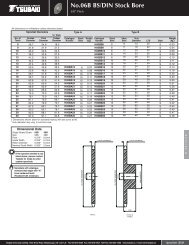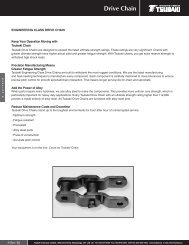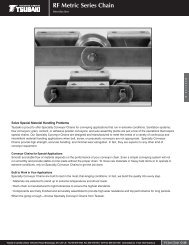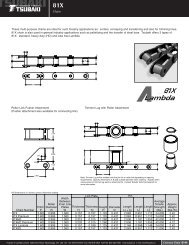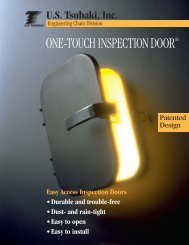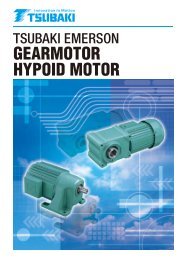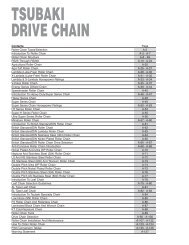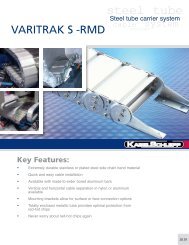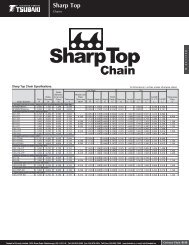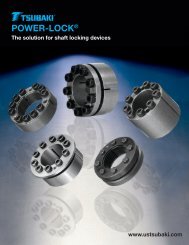DRIVE CHAINS - Tsubaki
DRIVE CHAINS - Tsubaki
DRIVE CHAINS - Tsubaki
Create successful ePaper yourself
Turn your PDF publications into a flip-book with our unique Google optimized e-Paper software.
GlossaryT S U B A K I D R I V E C H A I NBefore Use For Safe UseStandard Roller Chains Lube-Free Roller Chains Heavy Duty Roller Chains Corrosion Resistant Roller Chains Specialty Roller Chains Accessories Selection Handling1. ANSI Standard Minimum Tensile Strength (Tensile Breakage Strength)2. <strong>Tsubaki</strong> Average Tensile Strength3. <strong>Tsubaki</strong> Minimum Tensile Strength4.Maximum Allowable LoadThis is the minimum tensile strength determined by ANSI Standard. If a roller chain breaksfrom a tensile load below this value, then it is non-compliant. In the case of multi-strand rollerchain, the single strand value is multiplied by the number of strands. (ANSI B 29.100)This is a fracture load reading obtained after a long period of actual tensile strength testing ofa large number of chain strands. Naturally, a roller chain may actually break at a higher orlower value than this, so it does not represent a guaranteed value. This value variesdepending on the manufacturer.This is a minimum value determined bystatistical processing at <strong>Tsubaki</strong>. If anyroller chain fractures by a tensile loadbelow this value, then it is noncompliant.This value varies dependingon the manufacturer.Testing MethodAs shown in Fig. 2, roller chain with over five links is fixed at both ends by clevises and isstretched until breakage occurs (JIS B 1801-2009). The type of fracture is indicated bybreakage of the roller chain or failure of its parts (Fig. 3.)Fig. 2 Tensile strength testThe maximum allowable load of roller chain (excluding Stainless Steel Chain and EngineeringPlastic Chain*) is the value derived from the lowest fatigue limit. When a load lower than thisvalue is repetitively applied to the roller chain, fatigue failure will never occur.According to the former JIS B 1801-1997, the maximum allowable load indicates abreakage load of Pmax = (Pm + Pa) = 2.2Pa at a frequency of 5 10 6 , when a newroller chain with over five links receives a repetitive load in linear operation. (Fig. 4)<strong>Tsubaki</strong> standards and catalog values are for 10 7 repetitions, or 2Pa. In other words, if<strong>Tsubaki</strong>’s maximum allowable load is indicated as maximum load (Pmax), then values in thiscatalog would increase 10%.Fig. 4 Summary chart of repetitive loadLoadFig. 1 Relationship between three tensile strengthsJIS minimum tensile strength<strong>Tsubaki</strong> minimum tensile strengthFrequencyFig. 3 Shape of fractureAverage tensile strengthTensile strength* Stainless steel and engineered plastic chains:Maximum allowable load is determined from specifying the surfacepressure between pins and bushes based on wear performance.Note that strength of offset links may belower than the chain itself.(Refer to each product page for details.)Time9



